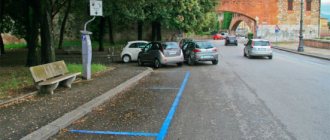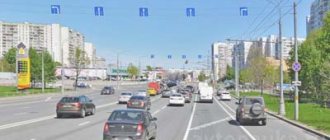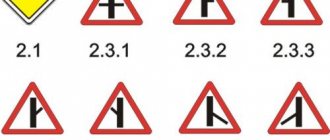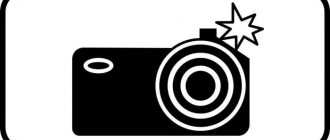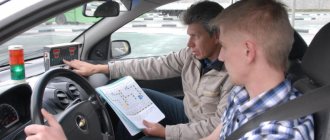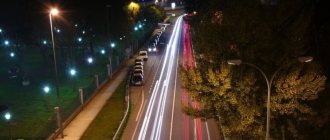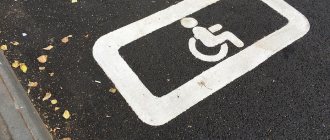Good afternoon, dear reader.
In this article we will talk about traffic signs , which are covered in Appendix 1 “Road Signs” to the traffic rules.
This article is the first article in the “Traffic Signs” series and it examines the most basic features of road signs: the division of signs into groups, the designations of each group, the features of their use.
Types of road signs in 2021
Currently, Appendix 1 to the Traffic Regulations has 8 sections, each of which deals with a separate group of road signs:
- warning signs;
- priority signs;
- prohibition signs;
- prescriptive signs;
- signs of special regulations;
- information signs;
- service marks;
- additional information signs.
Road signs are divided into groups in such a way that each group contains signs that are similar in meaning. Let's look at each type of sign in more detail.
Traffic warning signs
Warning road signs are the most useful and safest signs for a driver. Their safety lies in the fact that the requirements of warning signs cannot be violated , because These signs do not prohibit or restrict the driver. The main function of such signs follows from their name. They warn the driver about possible dangers and help avoid road accidents.
Warning signs are installed on dangerous sections of roads and can be easily distinguished from all other signs. Most warning signs look like a red triangle:
The only exceptions are signs related to railway crossings and “turn direction” signs. Their shape differs from a triangle:
Please note that all other warning signs are triangles .
Let me remind you once again that it is impossible to violate the requirements of warning signs, therefore, in the area of their coverage, a fine for violating the requirements of road signs in the amount of 500 rubles cannot be imposed.
However, warning road signs can warn you against violations that can result in very real penalties.
Consider an example with a “ dangerous turn ” sign:
If you come across a similar sign on the road, then you do not need to take any special action. However, you should keep in mind that after 150 - 300 meters outside a populated area or after 50 - 100 meters in a populated area there will be a dangerous turn on your way.
At a dangerous turn, overtaking is prohibited (clause 11.4 of the rules). Accordingly, for overtaking on a dangerous turn, the driver risks being punished in the form of deprivation of a driver’s license for 4-6 months or a fine of 5,000 rubles.
At the same time, the rules do not prohibit overtaking after the “dangerous turn” sign, but before the start of the most dangerous turn.
More detailed information about warning road signs is provided in the following articles:
Warning signs 1.1 - 1.12 Warning signs 1.13 - 1.23 Warning signs 1.24 - 1.35
New road signs and their meaning
White cross with red border
Installed immediately before the railway crossing.
Installed only if there is one path.
White cross with red border
Installed immediately before the railway crossing.
Installed when there are two or more paths (3, 4, 5, etc.). If there are no barriers at a railway crossing, signs 1.3.1 and 1.3.2 determine the size of the crossing.
Red stripes on a white background
Additional warning about approaching a railway crossing outside of populated areas. Installed outside at a distance of 150-300 meters, while the distance between the signs is proportional.
Signs 1.4.1-1.4.3 are installed on the right side of the road. and signs 1.4.4-1.4.6 are on the left.
Tram in a white triangle with a red border
Installed in n. p. 50-100 m. before the intersection with the tram line, outside the street. n. - for 150-300 m, can be installed at a different distance, but the distance is specified in table 8.1.1 “Distance to object”.
1. With simultaneous traffic rights (when the vehicles are in equivalent conditions), tram drivers have priority. 2. Outside intersections where tram tracks cross the path of trackless vehicles, the tram has priority, except when leaving the depot. 3. When “dividing” vehicles at intersections, there is no concept of “under the cover of trams.”
For your convenience, the manual is divided into several parts, each dedicated to a separate section. Each section contains road signs with pictures and explanations.
By spending about 5 minutes on each part, you can easily learn to understand the main road signs and easily navigate urban or suburban traffic:
PROHIBITED SIGNS
Priority signs
Priority signs, unlike warning signs, establish priority right of passage at intersections, intersections of roadways, and narrow sections of the road.
In this case, you should pay attention that for violating the requirements of priority signs installed at an intersection, you can receive a fine of 1,000 rubles (Part 2 of Article 12.13 of the Administrative Code). For the same violation outside an intersection, a warning or a fine of 500 rubles may be imposed (Part 1 of Article 12.16 of the Administrative Code).
There are only 13 priority signs, so it’s quite easy to remember them even though they all have different shapes and colors.
Priority signs
Prohibition road signs
As the title of the section suggests, prohibition signs prohibit the driver from performing certain actions. This section is quite extensive, and it is not always possible to determine their meanings from images of signs. More detailed information about prohibition signs is presented in the following articles:
Prohibitory signs 3.1 - 3.5 Prohibition signs 3.6 - 3.10 Prohibition signs 3.11 - 3.16
Prohibitory signs 3.17 - 3.19 Prohibition signs 3.20 - 3.26 Prohibition signs 3.27 - 3.33
Here I would like to note that most often you can find the following road signs on the road:
| entry prohibited (brick road sign) |
| Movement Prohibition |
| turning is prohibited |
| overtaking is prohibited |
| maximum speed limit |
| stopping is prohibited |
| No parking |
Let's consider an example related to violation of the requirements of a road sign prohibited entry (brick). The punishment for this violation directly depends on which road the driver takes.
If the sign is installed before entering the territory of the organization or the courtyard area, then we are talking about a regular violation of the requirements of road signs (500 rubles).
If a sign prohibits entry onto a one-way road, then a violation will entail a fine of 5,000 rubles or deprivation of rights for a period of 4 to 6 months.
Which changes?
There are a lot of updates to the rules for using signs and markings. You can read all of them in a specially prepared review by RosDorNII.
We will consider the most significant and interesting for ordinary drivers and car enthusiasts.
The No Overtaking sign must be duplicated on the left
GOST 2004 previously had such a requirement. But not for 2-lane roads (one lane in each direction).
From now on, 3.20, as well as 3.22 (Overtaking is prohibited only by trucks) must be duplicated on the left on all roads, except for one-way roads, of course. Here it is not possible to overtake, according to traffic regulations, since there is no oncoming lane.
5.1.6 ... Signs 3.20 and 3.22 are duplicated on roads with one lane for traffic in each direction, sign 5.15.6 - on roads with three lanes for traffic in both directions.
New signs
As we mentioned above, the standard has been supplemented with new road signs in accordance with the requirements of traffic rules and some laws. Here is a list of all the new signs you may see on the roads after the changes.
- 1.35 according to the new GOST indicates the entrance to the intersection with “waffle” markings,
- 3.34 – ban on buses,
- 5.14.2 and 5.14.4 signal the beginning and, respectively, the end of the lane for cyclists,
- 5.35 and 5.36 mean the start and end zones of the zone with the restriction of the environmental class specified in the STS of the vehicle,
- 5.37, 5.38 in addition to the above road signs are valid only for a certain category of cars,
- 5.39 and 5.40 – beginning and end of the cycling zone,
- 7.14.1 symbolizes the customs control point,
- 7.21 – about refueling for electric vehicles,
- plate 8.4.3.1 is already used together with any sign and means that the sign applies to electric vehicles,
- 8.4.15, on the contrary, indicates that the sign does not apply to electric vehicles,
- 8.9.2 indicates that parking here is only possible with a special permit,
- 8.9.3 permits parking or parking only for cars of the diplomatic corps,
- 8.25 indicates that the sign applies to cars of the environmental class written on the plate,
- 8.26 prescribes that there is a charger for electric vehicles in the place symbolized by the road sign.
Cancel reflective surface for some signs
Priority signs are now prohibited from being built into square reflective boxes. Previously, this was rarely used, but it did not contradict GOST.
However, initially the form of such signs was developed with the aim that even from other directions of the roads it would be clear what kind of road signs they were. For example, “Give way” in the form of an inverted rectangle - and there are no other signs of the same shape. The same applies for the main road.
Therefore, now, with changes, this rule has been brought into line with the international Convention.
RFID marking in signs
Now, special chips can be built into structures equipped with retroreflective elements to read these structures (signs, markings and other designations) using special software). Another step towards self-driving cars.
The parking sign still does not cancel the stop ban
Now let’s look at an amendment that did not exist, but which many drivers were waiting for.
The fact is that for many years on the roads of Russia you can find a contradiction of signs, when on a section of the road, for example, with a local widening, there is a sign 6.24, indicating that you can park here. At the same time, 3.27 “Stopping is prohibited” was previously set.
So, the first road sign does not cancel the ban. And why it is needed at all then is not very clear.
The new GOST, unfortunately, did not reveal the answer to this subtlety, and therefore you need to park carefully even with a special sign.
Something else useful for you:
- Long intermittent markings: what does it mean, rules of application, length according to traffic rules and GOST?
- Road sign “Parking prohibited” according to traffic regulations: what is the coverage area, where and who can park?
- Changes in traffic rules in March 2021: new road sign 6.22 Photo and video recording
Blue markings in paid parking lots
In 2021, paid parking or vehicle stop zones may be indicated by intermittent blue markings. Here is an example of such a line given in RosDorNII:
In conclusion, we note that GOST 52289 is mandatory for compliance in the Russian Federation. This means that its instructions must be followed everywhere and without fail. This means that in theory, the absence, for example, of a duplicate no-overtaking sign can help in appealing the traffic police decision.
Mandatory signs
Mandatory road signs are the opposite of the prohibitory signs discussed above. Mandatory signs allow only certain road users to perform certain actions.
For example, a road sign “bicycle path” allows only cyclists:
Various fines may be imposed for violating the requirements of mandatory signs.
For example, for driving onto a pedestrian path, the driver will receive a fine of 2,000 rubles (Part 2 of Article 12.15 of the Administrative Code).
Mandatory signs 4.1 - 4.2 Mandatory signs 4.3 - 4.8
How to test yourself for knowledge of signs
Driving school students must know all traffic signs in order to pass the exam. However, even experienced drivers must remember the main road signs. Many are quite rare, for example, the sign “Low-flying aircraft” can only be found in airport areas. Similarly, “Falling stones” or “Wild animals” will cause harm to a driver who does not travel outside the city.
Therefore, even drivers with extensive experience would do well to test themselves on their knowledge of various types of road signs, specific signs and the consequences that will result from failure to comply with their requirements. You can do this using the latest online tickets on the topic of road signs valid in 2021.
Share on social networks:
More useful on the topic
How to properly start a manual vehicle: step-by-step instructions for beginners
23.05.2021
How to properly adjust the side and interior mirrors of a car yourself
08.04.2021
Signs of special regulations
Signs of special regulations combine elements of both prohibitory and prescriptive signs.
For example, sign 5.19.1 “pedestrian crossing” allows pedestrians to cross the roadway, and sign “maximum speed limit zone” prohibits speeding on a selected section of the road.
Penalties for violating the requirements of special regulations signs depend on the type of sign and can vary widely.
Signs of special regulations 5.1 - 5.7 Signs of special regulations 5.8 - 5.14 Signs of special regulations 5.15
Signs of special regulations 5.16 - 5.20 Signs of special regulations 5.21 - 5.26 Signs of special regulations 5.27 - 5.34
New signs 2021
And now the signs themselves.
Stopping and parking is prohibited
The new elements of these prohibition symbols bear arrows. Thus, there is no need to put two signs on opposite sides of the road if stopping and parking are prohibited both on the left and on the right on the roadway. Arrows now indicate which side of the road the parking and stopping ban applies to.
New no stopping signs
An intersection with a traffic jam
A completely new road sign for 2021, not modified from previously available ones. This sign prohibits (albeit a square sign, while all prohibiting signs in the Traffic Rules were round) entering the intersection in front of which it is installed, if there is a traffic jam at it.
Driving is prohibited at an intersection with congestion
Only U-turn allowed
Another new sign, similar to the old one, called “Turn Around”. But the old sign is square, and the new one is round and prohibits any direction on the route except for a U-turn.
Only U-turn allowed
Tram strip
By analogy with the bus one, a new road sign “Dedicated tram lane” has appeared. It means that it is designated, that is, entry of trackless vehicles is prohibited.
Tram strip
Bus lane direction
Now, in addition to the presence of a lane for route vehicles as such, there will be a new sign that will indicate the possible directions of such a lane, installed in front of intersections.
Explanation: it does not act to warn drivers of ordinary cars, but for drivers of these same route vehicles.
Bus lane direction
Lane directions
And these signs are inherited from the above ones, only a fragment changes. As you can see, you will have to look at these signs for a longer time, since there are quite a lot of elements on them, which may result from taking your eyes away from the road for a long time.
Lane directions
Allowed directions along the lane
These are simpler and more visual new signs that, unlike the previous ones, indicate the permitted directions of movement for the individual lane on which you are currently located.
Explanation: a series of new elements of the road network are presented much more widely than the previous ones.
Lane directions
End of lane
Two new traffic signs will mark the end of the lane. Not to be confused with the previously existing signs “Narrowing of the road” - they do not imply priority when changing lanes, but the new ones do (more precisely, a traffic rule clause obliging you to give way when changing lanes).
End of the current road lane
Pedestrian crossing signs
Two groups of new signs also appeared in copy 5.19.1 - Pedestrian crossing. The first group - now the sign itself has been reduced in size due to the yellow frame around it to attract more attention from drivers at unregulated crossings.
Also, 2 new signs will indicate a diagonal pedestrian crossing and will be installed in front of intersections.
New Pedestrian Crossing Sign with Yellow Frame
Diagonal pedestrian crossing
Turn right on red
An additional sign with a plate, used exclusively with traffic lights at intersections, appeared in 2021. It allows you to turn right on red, giving way to all vehicles coming from other directions at this intersection.
Give in to everyone and you can turn right
Directions of traffic along the lanes at the intersection along the route of movement
New signs will indicate possible driving directions at intersections that are far ahead. Unlike similar signs on a blue background, they warn drivers in advance about traffic arrangements.
Directions of traffic along the lanes at the intersection along the route of movement
Bicycle and pedestrian zone
Such a sign will designate an area in which only pedestrians and cyclists are allowed to travel. Such signs are traditionally valid until the corresponding sign for the end of the bicycle/pedestrian zone.
Bicycle and pedestrian zone sign
Sign End of bicycle/pedestrian zone
Paid and off-street parking signs
In addition to the usual “Parking” road sign, which is used only with plates, new ones have been added that do not require additional plates.
Free and paid parking signs
Off-street parking signs
Methods for setting up the vehicle and additional information
These signs also replaced the sign+plate pair, and now the method of placing the vehicle or additional information is indicated directly on the same canvas.
Method of setting up the vehicle
Additional information signs (plates)
Additional information signs serve to clarify the meanings of road signs from other sections.
For example, a “wet surface” sign indicates that the sign applies only to the period of time when the road surface is wet.
The above combination of signs means that overtaking on the road is prohibited only when the surface is wet.
There are no separate fines for violating the requirements of Section 8 signs. In this case, the type of punishment is determined by the sign, which is the main one and is located above the sign.
Plates 8.1 - 8.2Plates 8.3 - 8.5.3Plates 8.5.4 - 8.9
Plates 8.10 - 8.16Plates 8.17 - 8.22.3
